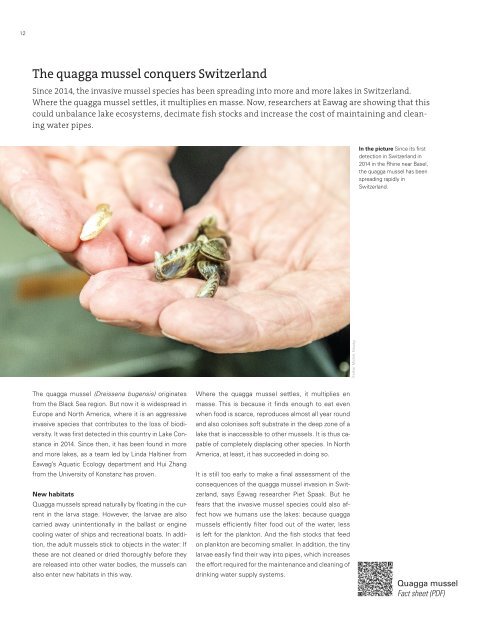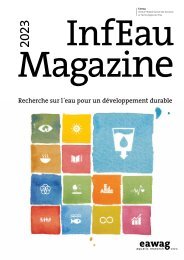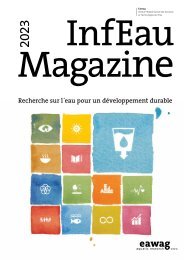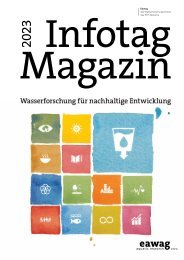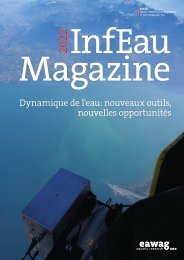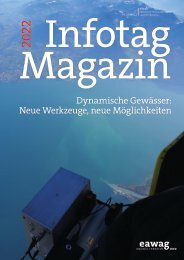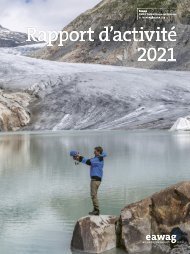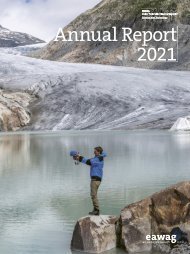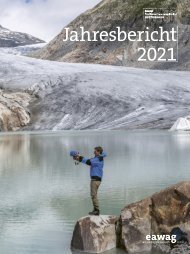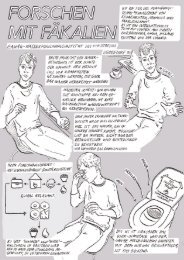Eawag Annual Report 2022
As the aquatic research institute of the ETH Domain, our research is in service of society. You can see this for yourself in our Annual Report. The annual compact review highlights the most relevant research results of the past year and shows how they were developed.
As the aquatic research institute of the ETH Domain, our research is in service of society. You can see this for yourself in our Annual Report. The annual compact review highlights the most relevant research results of the past year and shows how they were developed.
Create successful ePaper yourself
Turn your PDF publications into a flip-book with our unique Google optimized e-Paper software.
12<br />
The quagga mussel conquers Switzerland<br />
Since 2014, the invasive mussel species has been spreading into more and more lakes in Switzerland.<br />
Where the quagga mussel settles, it multiplies en masse. Now, researchers at <strong>Eawag</strong> are showing that this<br />
could unbalance lake ecosystems, decimate fish stocks and increase the cost of maintaining and cleaning<br />
water pipes.<br />
In the picture Since its first<br />
detection in Switzerland in<br />
2014 in the Rhine near Basel,<br />
the quagga mussel has been<br />
spreading rapidly in<br />
Switzerland.<br />
Esther Michel, <strong>Eawag</strong><br />
The quagga mussel (Dreissena bugensis) originates<br />
from the Black Sea region. But now it is widespread in<br />
Europe and North America, where it is an aggressive<br />
invasive species that contributes to the loss of biodiversity.<br />
It was first detected in this country in Lake Constance<br />
in 2014. Since then, it has been found in more<br />
and more lakes, as a team led by Linda Haltiner from<br />
<strong>Eawag</strong>’s Aquatic Ecology department and Hui Zhang<br />
from the University of Konstanz has proven.<br />
New habitats<br />
Quagga mussels spread naturally by floating in the current<br />
in the larva stage. However, the larvae are also<br />
carried away unintentionally in the ballast or engine<br />
cooling water of ships and recreational boats. In addition,<br />
the adult mussels stick to objects in the water: If<br />
these are not cleaned or dried thoroughly before they<br />
are released into other water bodies, the mussels can<br />
also enter new habitats in this way.<br />
Where the quagga mussel settles, it multiplies en<br />
masse. This is because it finds enough to eat even<br />
when food is scarce, reproduces almost all year round<br />
and also colonises soft substrate in the deep zone of a<br />
lake that is inaccessible to other mussels. It is thus capable<br />
of completely displacing other species. In North<br />
America, at least, it has succeeded in doing so.<br />
It is still too early to make a final assessment of the<br />
consequences of the quagga mussel invasion in Switzerland,<br />
says <strong>Eawag</strong> researcher Piet Spaak. But he<br />
fears that the invasive mussel species could also affect<br />
how we humans use the lakes: because quagga<br />
mussels efficiently filter food out of the water, less<br />
is left for the plankton. And the fish stocks that feed<br />
on plankton are becoming smaller. In addition, the tiny<br />
larvae easily find their way into pipes, which increases<br />
the effort required for the maintenance and cleaning of<br />
drinking water supply systems.<br />
Quagga mussel<br />
Fact sheet (PDF)


